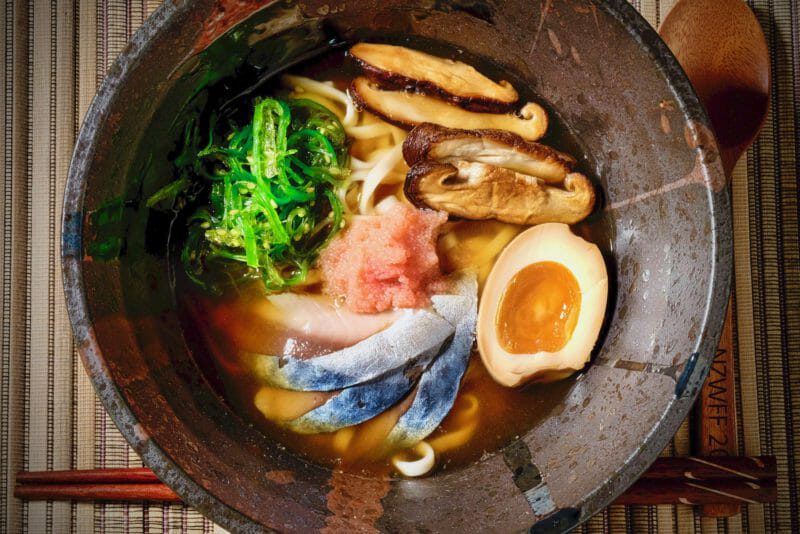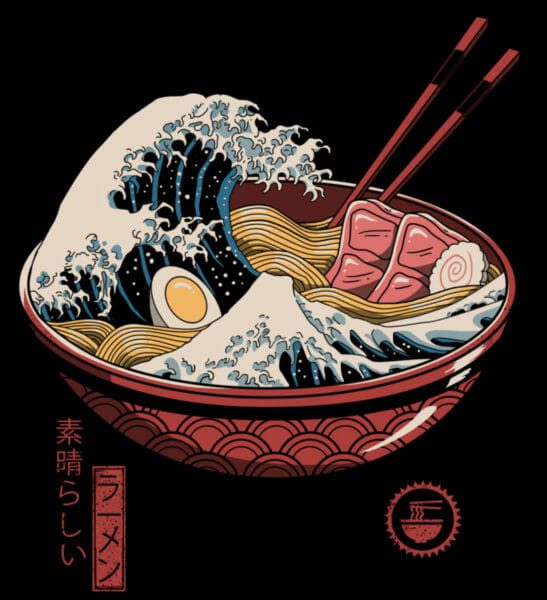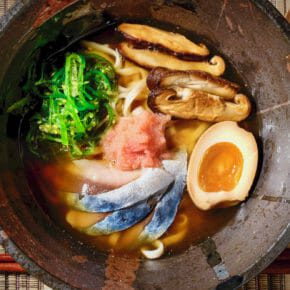
Building upon a pork and chicken bone broth, this seafood ramen adds some tastes of the ocean. The seafood flavours are engaging, making the shoyu broth more complex yet so satisfying.
Inspiration
It was at Sanpoutei Ramen in Singapore where I tasted the inspiration for this seafood ramen. Their Niigata Shoyu Ramen is infused with the flavours of dried sardines. Like dried anchovies, dried sardines come packed with umami. While adding a little of their own seafood flavour, the glutamates they contribute greatly enhance the other flavours in the shoyu broth and all that it touches.
The seafood influence in this ramen soup is subtle. The dried anchovies enhance the flavour of the pork and chicken bone stock while also adding umami. It is worth taking the time to create your own stock. Not only will it taste better, but you will have control over the seasoning. Almost all store-bought stock will have salt added. That means that you would have to adjust the saltiness of the tare to compensate.

“The Great Ramen Wave” Vincent Trinidad Art – seemed appropriate
Ramen, when referring to the dish as a whole, as opposed to the type of noodles, is diverse. There are some broad categories, however. One is miso ramen, such as this red miso ramen. This dish, seafood ramen incorporating tastes of the ocean, is of the shoyu ramen style. Soy sauce is the seasoning used for shoyu ramen. It is sometimes referred to as a Tokyo ramen. Serious Eats has an exquisite description…
Tokyo ramen is made with pork and chicken broth and features slightly curly, moderately wide noodles. Very often in Toyko, you’ll find broths that are flavoured with dashi, a broth made from dried, smoked bonito flakes and sea kelp. This dashi-chicken hybrid is a cross-breed of Chinese-style soup broths with the lighter Japanese broths used in traditional Tokyo soba (buckwheat noodle) shops.
Serious Eats
Layers
“Layers of flavour” is a concept often mentioned in culinary exposés on ramen. These layers are achieving by combining the different soup components (stock, dashi, tare, etc.) in the bowl immediately before serving. I was a little sceptical. How could mixing it in the bowl result in layers of flavour where mixing it in the saucepan could not?
I need to find out why this works, but it does work. When eating a bowl of this shoyu ramen, the “layers” were distinct – the flavor foundation and mouthfeel of the bone broth, the savory yet subtle ocean flavor of the dashi, and the seasoning from the tare. It was a revelation that made all that effort creating this bowl of ramen so worthwhile.
Toppings
The marinated egg (ajitsuke tamago) and the sautéed shiitake mushrooms are typical ramen toppings. Ramen just wouldn’t be the same without the ajitsuke tamago. It is the other three toppings that you are less likely to find on restaurant bought ramen.
Nearly every bowl of ramen sold is served with a slice or two of pork or chicken chashu. That fatty, melt-in-your-mouth decadence is delicious when done well. However, I wanted to use something more aligned with the seafood ramen/“taste of the ocean” theme. I first experimented with thinly sliced fish cake as a chashu substitute. While it worked quite well, I ended up going for something completely different: sashimi-grade mackerel. One variation of phở involves pouring the hot soup over thinly sliced raw beef, lightly cooking the beef as the soup flows over it. The same thing happens with the mackerel. As a bonus, mackerel has such a distinctive ocean flavour.
Carrying on the ocean theme, the “green vegetable” is a seaweed salad. You can make this yourself, or buy ready-made (e.g. this one) from your supermarket or Asian store. Bonus: seaweed is incredibly healthy.
A dollop of pink intensity in the centre is mentaiko. Mentaiko is a cod roe that has been cured and marinated in seasonings and spices, including chilli pepper. It is so full of flavour, holding its own against the bold ramen soup. I buy mentaiko from a Japanese grocery shop in Saigon. If you don’t have such a store near you, you can purchase it online in canned form from Amazon. Alternatively, substitute it with a piece of kamaboko.

Ramen with a taste of the ocean
Ingredients
Pork and chicken bone broth
- 1 liter pork and chicken bone broth
Niboshi dashi
- 15 g kombu
- 40 g niboshi dried anchovies, weight after heads and gut removed
- 20 g dried shiitake mushrooms 3 or 4
- 15 g katsuobushi
- 1.5 liter water
Ajitsuke Tamago (soft boiled and marinated eggs)
- 4 eggs
- 1/4 cup soy sauce
- 1/4 cup mirin
- 1/4 cup sake
- 20 g katsuobushi
- 2 Tbsp sugar
Tare
- 225 ml soy sauce
- 50 ml mirin
- 20 ml fish sauce
- 5 g salt
- 10 g kombu
- 10 g dried shiitake mushrooms
- 1 thumb ginger
- 3 cloves garlic
- 10 g niboshi dried anchovies, weight after heads and gut removed
Noodles and toppings
- Ramen noodles 4 servings
- Fresh shiitake mushrooms
- Mackerel sashimi or some sort of fish cake, or even pork chashu
- Seaweed salad from the sushi counter at your supermarket, or buy from a Japanese restaurant. Alternatively use pickled wakame or spinach.
- Mentaiko or red or black fish roe, or kamaboko
Instructions
Ajitsuke Tamago (soft boiled and marinated eggs. Start 1 day ahead)
- Combine the soy sauce, mirin, sake, and sugar in a saucepan over a medium heat and bring up to a boil.
- Remove from the heat and add the katsuobushi.
- Allow to cool for 10 minutes then strain.
- Bring a medium saucepan full of water to a boil then reduce to a simmer.
- Pierce the eggs at the wider end with a needle or egg piercer. This removes the air pocket and makes them easier to peel.
- Lower the eggs into the water and cook for exactly 6 minutes. Turn the eggs occasionally in the first minute to help the yolks be centered.
- Transfer the eggs to an ice bath to halt the cooking.
- Carefully peel the eggs, starting at the wider end that was pierced..
- Put the eggs and soy marinade into a zip-lock plastic bag, remove any air, and seal.
- Store in the refrigerator for 48 hours, moving occasionally to ensure even coverage of the marinade.
- Drain after 48 hours and discard the marinade. Store in the refrigerator until needed.
Niboshi dashi (Start 1 day ahead)
- Break off the heads and remove the guts from the niboshi as it can add a bitter flavour.
- Add the kombu, niboshi, and shiitake mushrooms to the 1 liter of water.
- Cover and allow to soak overnight.
- Add the water and contents to a saucepan. Heat until just before boiling then remove from the heat.
- Add the katsuobushi to the saucepan.
- Allow to sit for 10 minutes then strain the dashi liquid through a fine strainer into another container. Discard the solid ingredients.
Tare (Start 1 day ahead)
- Peel and finely chop the garlic and ginger.
- Break up the shiitake mushrooms.
- Put all ingredients in a saucepan and bring to a boil then remove from the heat.
- Allow to cool overnight.
- Strain and discard the solid ingredients.
Noodles and toppings
- Remove the stem from the shiitake mushrooms and dice.
- Sauté until starting to brown.
- Drain and set aside.
- To prepare the mentaiko, scrape the eggs from the egg sac. Set aside.
Serving
- Bring the bone broth, and the dashi to a rolling simmer.
- Drain the Ajitsuke Tamago (eggs) and halve.
- Cook the ramen noodles according to the instructions on the packet. Probably boil for something like 5 minutes.
- Warm the bowls.
- Add 30 ml tare, 150 ml bone broth, and 150 mi dashi to each bowl, together with one portion of noodles.
- Top with mackerel, seaweed salad, shiitake mushrooms, half an egg, and the mentaiko.


 Sake panna cotta with a blueberry reduction
Sake panna cotta with a blueberry reduction »
»